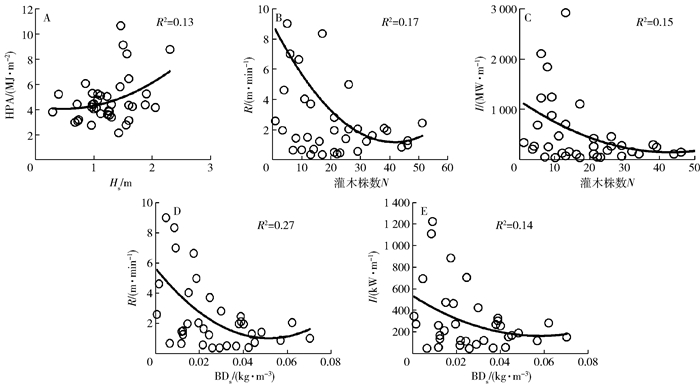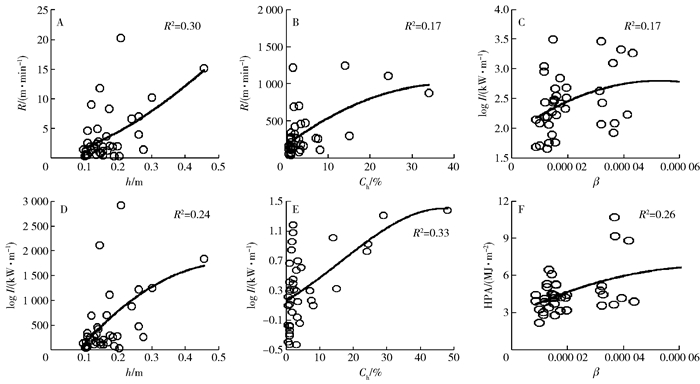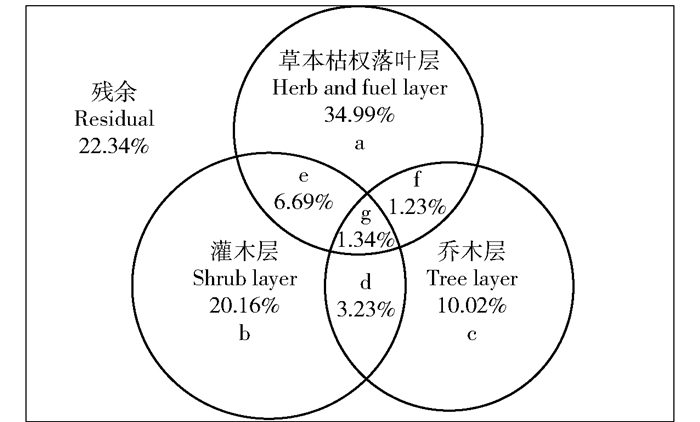Correlations between stand structure and surface potential fire behavior of Pinus tabuliformis forests in Miaofeng Mountain of Beijing
-
摘要:目的林分结构与火行为密切相关,调整林分结构可以有效降低火行为,对森林防火工作有指导意义。分析北京妙峰山油松林分结构与地表潜在火行为的相关性,探究林分结构指数对地表火行为的影响,为妙峰山油松林可燃物管理提供科学依据。方法本文以妙峰山地形相近、结构差异较大的油松林为研究对象,调查和测定样地中的乔木、灌木、草本和枯枝落叶数据,利用Rothermel模型计算油松林潜在火行为指标,采用相关性分析、回归分析及方差分解法,研究油松林地表潜在火行为与林分结构的关系。结果(1) 油松林地表潜在火蔓延速度(R)、火强度(I)、单位面积热量(HPA)取值范围分别在2~6m/min、300~1400kW/m、4000~5500kJ/m2之间。(2)潜在火行为与结构指数相关性:乔木层R、I与平均树高呈显著正相关,与平均枝下高、平均冠幅、冠长率相关性较小。灌木层R、I与灌木密度、株数呈显著负相关,而与高度相关性较小;HPA与灌木高度呈显著正相关。灌木密度、株数过大或过小都有利于增强地表潜在火行为,反而灌木量适中时地表潜在火行为较低。草本枯枝落叶层I与床层高度、草本盖度呈极显著正相关,紧密度与logI呈显著正相关与HPA呈极显著正相关。(3)对地表潜在火行为的解释力,草本枯枝落叶层结构指数>灌木层结构指数>乔木层结构指数,草本枯枝落叶层和灌木层结构指数的交互作用贡献率大于乔木层与草本枯枝落叶层、灌木层结构指数的交互作用。结论妙峰山油松林普遍处于低强度地表火,可引发中强度地表火,有引发高强度地表火的可能。地表潜在火行为与乔木层、草本枯枝落叶层结构呈正相关,而与灌木层结构呈负相关;其中,乔木层的树高,灌木层的密度、株数、盖度,草本枯枝落叶层的草本盖度、床层高度、紧密度对地表潜在火行为产生显著影响,各个层次的影响由大到小分别为草本枯枝落叶层>灌木层>乔木层。整体来看,地表潜在火行为大小主要受到地上可燃物的影响尤其是草本枯枝落叶层,而乔木层的影响相对较小。Abstract:ObjectiveStand structure is closely related to the fire behavior. Adjusting the stand structure can effectively lower the fire behavior. Analysis of the relationship between the structure of Pinus tabuliformis forest and the potential fire behavior on the surface of Miaofeng Mountain in Beijing provides scientific basis for the development of Miaofeng Mountain combustibles management measures.MethodIn this paper, the Pinus tabuliformis forest with similar topography and large structural difference was taken as the research object, and the data on trees, shrubs, herbs and fuel in the plot were investigated and measured. The fire behavior index was calculated by Rothermel model. The Pearson correlation analysis method was used to study the potential fire behavior of Pinus tabuliformis forests and its relationship with stand structure.Result(1) The potential fire spread rate (R), fire intensity (I) and unit area combustible heat (HPA) of Pinus tabuliformis were 2-6m/min, 300-1400kW/m and 4000-5500kJ/m2, respectively. There were also several larger values with fire behavior. (2) For the correlation between surface fire behavior and stand structure, in the arbor layer, R, I and average tree height (H) showed significantly positive correlations, and had little correlations with height of the lowest branches(Ht), cverage crown (Ct), the rate of crown length (TCRt) and diameter at breast height (Dg). In the shrub layer, R, I had a significantly negative correlation with shrub density (BDs) and N, but less correlated with shrub number (Hs). There was a significantly positive correlation between HPA and Hs. And BDs, N too large or too small were conducive to enhance the surface fire behavior, but when the shrub was moderate, the surface fire behavior was the lowest. In the layer of herb and fuel, bed height (h), herb coverage (Ch) and I showed a significantly positive correlation. The significant correlation between tightness (β) and logI was significantly correlated with HPA.(3)Interpretation of potential fire behavior on the surface, herbaceous fuel layer structure index>shrub layer structure index>arbor layer structure index. The interaction of herbaceous fuel layer and shrub layer structure index contributed the most.ConclusionThe potential fire behavior of Pinus tabuliformis forest is generally in low-intensity surface fire, which can cause medium-intensity surface fire and has the possibility of causing high-intensity surface fire. The potential fire behavior on the surface is positively correlated with the structure of the tree layer and the herb fuel layer, but negatively correlated with the shrub layer structure. Among them, the Ht of the arbor layer, the BDs, N and shrub coverage (Cs) of the shrub layer, and the Ch, h and β of the herb and fuel layer have significant effects on the surface potential fire behavior, and the effects of each level are herbaceous fuel litter layer>shrub layer>arbor layer. On the whole, the potential fire behavior of the surface is mainly affected by the above-ground combustibles, especially the herbaceous fuel layer, while the influence of the arbor layer is relatively small.
-
火行为(Fire behavior)是指可燃物被引燃、发展、蔓延直至熄灭整个过程表现出来的综合特征[1]。常见林火类型有地表火、地下火、树冠火,还包括飞火、火旋风等特殊类型[2-4],不同的林火种类表现出不同的火行为,而林下可燃物、火环境(气象、地形和植被)及火源等条件制约着林火的发生[5-6],直接影响火行为的发生、发展和蔓延[7]。
近年来,国内外学者对可燃物火行为特征进行了大量的研究。Klutsch等[8]利用美国科罗拉多州中北部地区松树(Pinus spp.)建群种,研究山松甲虫(Dendroctonus ponderosae)爆发后的潜在火行为特征,指出山松甲虫引起林分和可燃物特性的变化造成了地表火行为增加。Goodrick等[9]应用地表火行为模拟系统,选择美国南部地区不同林龄桉树(Eucalyptus robusta)为研究对象,评估美国南部桉树潜在火行为风险变化。王秋华等[10]利用BehavePlus软件对昆明西山国家森林公园主要树种进行潜在火行为特征研究,指出可燃物负荷量对火行为起到决定性作用。王凯等[11]基于Rothermel模型在不同含水率下对北京鹫峰国家森林公园的潜在火行为进行了探究,认为较低含水率有利于地表火的发生和蔓延。可以看出,对潜在火行为的研究主要集中在小尺度、生物学、生态学特征上的评价分析,而林下植物的组成、生长状况、空间分布和配置等林分因子对潜在火行为的影响研究较少。
本文以北京妙峰山林场分布最广、面积最大、最有代表性的油松(Pinus tabuliformis)林为研究对象,通过Rothermel模型[12]计算油松林地表潜在火行为指标,利用相关性分析、回归分析和方差分解法,探讨油松林地表潜在火行为特征与林分结构指数的相关性,期望通过林分结构调整可以有效降低地表潜在火行为,对控制森林火灾发生、发展具现实意义[13-14]。
1. 研究区概况
北京妙峰山位于北京海淀区(39°54′N、116°28′E),横跨海淀、门头沟2区,总面积832.04hm2。海拔为100~1153m,坡度16°~35°。属于暖温带大陆性季风气候,年均气温为12.2℃,最高气温39.7℃,最低气温-19.6℃,年降水量近700mm,多集中在7—8月,占全年降水量75%。
该地区自然资源丰富,森林覆盖率高达96.2%。天然植被为典型的暖温带落叶阔叶林,现在以次生林和人工林为主。目前主要的森林类型是以油松和侧柏(Platycladus orientalis)为主的针叶林,山顶区域覆盖有部分华北落叶松林(Larix principis-rupprechtii); 阔叶林主要为栓皮栎(Quercus variabilis)林、槲栎(Q. aliena)及刺槐(Robinia pseudoacacia)林。林下植被主要由荆条(Vitex negundo var. heterophylla)、小叶鼠李(Rhamnus parvifolia)、孩儿拳头(Grewia biloba)、胡枝子(Lespedeza fioribunda)、绣线菊(Spiraea trilobata)等灌木和茜草(Rubies cordifolia)、求米草(Cheuopodium album)、狗尾草(Setaira viridis)披针叶苔草(Carex lanceolata)等草本组成。
2. 研究方法
2.1 外业调查
通过对研究区域的全面踏查,选择连续性较好、人为干扰较少具有代表性地段的油松林,分年龄阶段和林分结构设置8块20m×20m标准地。在每个标准地内,测定林分郁闭度、海拔、坡度、坡向和坡位,对林分的乔木层、灌木层、草本枯枝落叶层进行调查。分树种测定树高、胸径、冠幅、活枝下高和死枝下高。在标准地内设置5m×5m样方16个,进行灌木、草本和枯枝落叶层调查。在5m×5m样方内测定灌木种类、灌木盖度、高度,全部收割并分别称质量、取样; 收集10时滞和100时滞枯枝,称质量,取样。在每个5m×5m样方内,固定一个角设置1m×1m样方1个,测定草本植物种类、盖度和高度,分种类收割并称质量、取样; 收集1m×1m样方内1时滞枯枝,称质量、取样; 枯枝落叶上层,收集、称质量、取样; 并测定各层的厚度。可燃物干质量测定,使用塑料袋装载,电子钩秤(精度1g)称取质量,并扣除塑料袋的质量; 采集样品100g左右放入统一规格的牛皮纸信封内,采用电子天平(精度0.01g)称质量,记载日期、标准地号、可燃物种类、质量。把样品带回实验室对可燃物理化性质进行测定。其中,可燃物种类划分标准见表 1[15-16]。
表 1 可燃物种类划分标准Table 1. Classification criteria for fuel类别Category 灌木层Shrub layer 草本层Herbal layer 枯枝落叶层Litter layer 规格Specification 叶Leaf 鲜草Fresh grass 活可燃物Living combustible 小枝Small branch 直径Diameter < 1cm 大枝Big branch 直径Diameter≥1cm 枯草Withered grass 1时滞枯枝Dead branch 1hr 直径Diameter < 0.6cm 枯死可燃物Dead combustible 10时滞枯枝Dead branch 10hr 0.6~2.5cm 100时滞枯枝Dead branch 100hr 2.5~7.5cm 枯叶Withered leaf 落叶层Leaf litter layer 2.2 实验方法与计算
2.2.1 可燃物理化性质
野外采集的样品放入电热风干燥箱内,在105℃条件下,将可燃物烘干至恒质量,根据样品干湿比及野外调查的各类可燃物质量,得出每个样方可燃物负荷量计算公式:
Woi=n∑j=1Woij=n∑j=1WijSj (1) 式中:Woi为第i个样方的有效可燃物负荷量(kg/m2),Woij为第i个样方第j种类可燃物负荷量(kg/m2),Wij为第i个样方第j种类可燃物干质量(kg),Sj为第j种类可燃物调查的样方面积(m2)。
将野外样品烘干、粉碎,取1g压成样品块,再烘干去除水分,用分析天平准确称量(精确到0.0001g),使用PRR3600型全自动氧弹式热量仪测定样品的热值(kJ/kg)。每种可燃物样品做3个重复,求平均值。采用可燃物负荷量加权平均法,计算林分层次可燃物种类的加权平均热值。
最后,根据牛树奎等[15]、Wagner[17]、Bradshaw等[18]研究,有效可燃物总矿质含量0.0555,有效矿质含量0.010;1时滞表面积体积比1250m-1,10时滞表面积体积比253m-1,100时滞表面积体积比77m-1,1000时滞表面积与体积比6.7m-1。参考牛树奎等[15-16]利用表面积载量加权平均法,计算样方可燃物的理化性质。
2.2.2 地表潜在火行为指标计算
胡海清等[1]、Bradstock等[2]和Rothermel[12]指出地表潜在火行为指标普遍较多,通常蔓延速度(Spread speed,R)、火强度(Fire intensity,I)和单位面积热量释放(Heat release per unit area,HPA)这3个指标最具有代表性,能够充分显示出不同森林类型地表潜在火行为状况。因此,本文选择地表火蔓延速度、地表火强度和地表单位面积热量释放作为地表潜在火行为的评价指标。
(1) 地表潜在火行为的计算参考Rothermel模型[12]。其中,反应强度(IR)与可燃物热值、有效负荷量、潜在反应速率、矿物质抑制系数、水分阻滞系数成正比。参考单延龙等[19]转换为国际标准:
R=IRξ(1+ΦW+ΦS)ρbεQg (2) 式中:R为火蔓延速度(m/min),IR为反应强度(kJ/(m2·min)),ξ为与热传导有关的系数,ΦW和ΦS分别为风速和坡度影响系数,ρb为复合可燃物烘干颗粒体密度(kg/m2),ε为与体密度有关的加热系数,Qg点燃单位质量可燃物需要的热量(kJ/kg)。
(2) 地表火强度主要是指燃烧时火头释放热量的速度,是火行为重要指标之一,直接与火焰强度有关[1]。美国物理学家Byram[20]在1959年提出计算火线强度公式。本研究参考单延龙等[19]和牛树奎等[15-16]转换为国际标准:
I=160HWR (3) 式中:I为火线强度(kW/m),H为可燃物热值(kJ/kg),W为有效可燃物负荷量(kg/m2),R为林火的蔓延速度(m/min)。
(3) 单位面积释放热量是指地表火头前端单位面积所释放的热量,不受外界环境的影响仅受可燃物负荷量与其热值的影响[1],一般由以下公式计算[21]:
HPA=TRIR=1259.5IRσ (4) 式中:HPA为单位面积释放热量(kJ/m2),IR为反应强度(kJ/(m2·min)),TR为驻留时间(min),σ为可燃物表面积与体积比的负荷量加权平均值(m-1)。
2.2.3 林分结构指数
本文研究的林分结构包括乔木层和地表层2个主层级,地表层又分为灌木层和草本枯枝落叶层。乔木层选择平均胸径(The average DBH,Dg, cm)、平均树高(The average height,H, m)、平均枝下高(Height of the lowest branches,Ht, m)、平均冠幅(Cverage crown,Ct, m)、冠长率(Rate of crown length,TCRt, %)[22]。地表层包括灌木层和草本枯枝落叶层[22]。其中灌木选择灌木密度(Shrubs density,BDs, kg/m3)、平均盖度(Average coverage,Cs, %)、灌木株数(Shrub number,N)、灌木高度(The average height,Hs, m)这几个指标[23]。草本枯枝落叶层主要选择床层高度(Bed heigh,h, m)、草本盖度(Average coverage,Ch, %)、紧密度(Tightness,β)[12]。
2.2.4 数据处理
本研究使用SPSS 21.0、R统计软件和Ecxel 2016进行数据计算。利用Rothermel模型计算的地表潜在火行为特征值采用箱式图表示,这样可以直观的看出油松林地表潜在火行为的分布特点,分析比较多组数据平均水平和变异程度[24]。
使用SPSS 21.0统计软件进行相关性和回归分析,首先分析地表潜在火行为和林分因子的关系,接着选择与地表潜在火行为有显著相关性的林分结构指标,分析潜在火行为随林分结构的具体变化趋势,最后利用方差分解法计算各层林分结构因子对地表潜在火行为影响的贡献率。其中,方差分解一般分为3个步骤:求取各方差组分、方差各组分的显著性检验、拟合值作图,整个过程可以由R统计软件中的Vegan软件包实现[25]。
3. 结果与分析
3.1 油松林地表潜在火行为特征分析
北京市在防火季节的最大风速为7.6~4.0m/s,平均为5.8m/s。由于森林对风的削减作用,接近树冠时风速降低,一般按照直减率0.4[26],则林下取风速2m/s,作为作用在火焰上的风速平均值,坡度值按照样地调查坡度。由于本文只考虑林分因子对地表潜在火行为的影响,因此设置外界条件相同。
图 1为油松林地表潜在火行为特征值的箱式图,反映了油松林潜在火强度、火蔓延速度和单位面积热量3个指标的最大值、最小值、平均水平、集中区域及变化程度。
在森林火灾防控中,一般将火强度划分为不同的等级:低强度火(350~750kW/m)、中强度火(750~3500kW/m)、高强度火(3500kW/m)[27]。由图 1可以看出,油松林地表潜在火行为普遍处于较小范围,为低强度地表火。其中,蔓延速度主要集中在2~6m/min,均值为3m/min,最小值1.5m/min,最大值10.5m/min,有4个特殊值分别为11、15、20、23m/min。火强度主要集中在300~1400kW/m,含有4个特殊值1900、2100、2800、3100kW/m。单位面积释放的热量主要集中于4000~5500kJ/m2之间,也有4个特殊值都在8000kJ/m2以上。某些油松林一方面受到局部地形的影响,特别是小部分凸起的地形,有利于可燃物积累和林火的蔓延; 另一方面该油松林为成熟林,人为干扰小,导致林内较干燥,可燃物积累较多,多种因素综合作用下导致个别油松林潜在火行为较大。
3.2 油松地表潜在火行为与林分结构的关系
可燃物的潜在火行为除受到风速、坡度、含水率等外界环境和自身理化性质的影响,同时还受林分结构的影响。表 2为地表可燃物潜在火行为和林分因子的Pearson关系。
表 2 油松林地表潜在火行为与林分结构的相关系数Table 2. Correlation coefficients between surface fire behavior and stand structure of Pinus tabuliformis可燃物层Combustible layer 相关性系数Correlation coefficient R I HPA 乔木层Tree layer 平均枝下高Average height of the lowest branches (Ht) 0.220 0.218 0.139 平均冠幅Average crown width (Ct) -0.038 -0.042 0.168 冠长率Rate of crown length (TCRt) 0.136 0.151 -0.101 平均胸径Average DBH (Dg) 0.134 0.164 0.281 平均树高Average tree height (H) 0.391* 0.399* 0.075 地表层
Surface layer灌木层Shrub layer 灌层密度Shrub density (BDs) -0.427** -0.361* 0.219 平均盖度Average coverage (Cs) -0.241 -0.217 -0.065 平均高度Average height (Hs) 0.013 0.150 0.360* 株数Shrub number (N) -0.372* -0.346* -0.044 草本枯枝落叶层
Herb and fuel litter layer床层高度Bed height (h) 0.539** 0.519** -0.034 紧密度Tightness (β) 0.290 0.391* 0.482** 平均盖度Average coverage (Ch) 0.523** 0.524** -0.289 注:**表示在P < 0.01水平上极显著相关,*表示在P < 0.05水平上显著相关。Notes: ** means significant correlation at P < 0.01 level (bilateral), * means significant correlation at P < 0.05 level (bilateral). 在表 2中,各层林分结构指数与地表潜在火行为的相关性系数差异较大。其中,h、β、Ch分别与R、HPA、I的相关系数最大,BDs、Cs、N与R的相关系数次之,H与R、I的相关系数最小。表明乔木、灌木、草本枯枝落叶各层结构因子都会对油松林地表潜在火行为产生影响,由大到小顺序为:草本枯枝落叶层>灌木层>乔木层。同时,草本枯枝落叶层结构因子与油松地表火的关系最密切,影响地表潜在火行为的指标主要有h、Ch、β。其中,h、Ch分别与R、I呈极显著正相关(r分别为0.539、0.519、0.523、0.524);β与I呈显著正相关(r=0.391)与HPA呈极显著正相关(r=0.482)。灌木层中的BDs分别与R、I呈极显著负相关(r=-0.427)和显著负相关(r=-0.361);N分别与R、I呈显著负相关(r=-0.372、r=-0.346);Hs与HPA呈显著正相关(r=0.360),与R、I相关性不显著。乔木层中只有H与R、I呈显著正相关(r=0.391、r=0.399),与HAP相关性不显著; 而Ht、Ct、TCRt、Dg对R、I、HPA的影响均不显著。
3.2.1 地表潜在火行为与乔木层结构因子的回归分析
乔木层林分结构是间接影响地表火行为的主要因素[28]。选择表 2乔木层中,对潜在火行为呈显著相关性的林分结构因子,利用回归分析法绘制潜在火行为的变化趋势图(图 2)。
由图 2可以看出,随着H的增加R、I先缓慢增加,H达到6m时增加速度加快; 即当H < 6m时,潜在火行为指数较小,且潜在火行为缓慢增加,说明油松林龄较小时易形成低强度地表火。当H>6m时,随着H的增大,潜在火行为指数较大,且潜在火行为增加速度也加快,说明林龄较大时油松可能形成高强度地表火,危害较大、不易控制。原因可能是当油松较小时,灌木和枯枝落叶量也较少,地表潜在火行为较低; 而随着树木的生长,地表灌木和枯枝落叶逐渐增加,地表潜在火行为也增大。
3.2.2 地表潜在火行为与地表层结构因子的回归分析
地表层直接影响地表潜在火行为,油松林普遍以灌木和草本枯枝落叶层为燃烧主体,选择与潜在火行为呈显著相关性的地表层林分结构指数,利用回归分析绘制地表潜在火行为的变化趋势图(图 3)。
在图 3A中,Hs与HPA呈正相关,随着Hs的增加HPA也逐渐增加。同时,在Hs为1.5m左右时,HPA出现了几个特殊值; 可能由于灌木负荷量不仅受到灌木株数、种类等其他多种因素影响,还受到灌木自身高度的影响,当灌木高度大于1.5m时,利于可燃物的引燃。在图 3B、3C、3D、3E中,N、BDs与R、I负相关,随着N和BDs的增大R、I先逐渐下降,当BDs和N分别为40株、0.053kg/m3左右时,R、I达到最小值之后又有增大趋势。说明灌木林太少和太多时,都有利于增强地表潜在火行为,反而灌木林适中时,潜在火行为较低。可能是当灌木太少时,林内郁闭度大、地表草本枯枝落叶较多,地表潜在火行为较大; 而灌木较多时,林内灌木负荷量大,有利于形成树冠火,地表潜在火行为也较大。因此,油松林中灌木的增加利于地表可燃物热量释放,灌木1.5m左右时有利于树冠火的形成; 林龄较大林分中,灌木层对地表潜在火行为起到一定的阻碍作用,特别是对林火蔓延速度的影响。
在图 4A、4D中,h与R、logI正相关,随着h增大,R、logI先快速增加,之后logI的增加量开始减少,因此适当降低床层高度有利于降低地表潜在火行为。在图 4B、4E中,Ch与logI正相关,当Ch小于38%时,logI随着Ch的增加迅速增大,当Ch达到45%时,logI几乎不再增加逐渐平缓; Ch与R也呈正相关,且随着Ch增加,R逐渐增加,最后趋于平缓。在图 4C、4F中,β与logI呈正相关,与HPA也呈正相关,当β增加时,HPA也逐渐增加,而logI先逐渐增加之后也趋于平缓。所以草本枯枝落叶层对地表潜在火行为的影响,有一定的限度; 通常随着草本枯枝落叶层可燃物增加地表潜在火行为逐渐增加,达到一定阈值后会趋于平缓。
3.3 林分结构对地表潜在火行为影响的解释力分析
本文通过方差分解法研究乔木、灌木和枯枝落叶层3类林分结构因子对油松林地表潜在火行为影响的解释程度(图 5)。
油松林分结构对地表潜在火行为影响的解释力中,草本枯枝落叶层结构的独立贡献率(34.99%)大于灌木层结构的独立贡献率(20.16%),并且显著大于乔木层结构的独立贡献率(10.2%); 灌木层结构与草本枯枝落叶层的交互作用(6.69%)大于乔木与灌木层(3.23%)和乔木与草本枯枝落叶层(1.23%)的交互作用,且3类林分结构能够解释的累积贡献率77.66%。这可能是由于油松林草本枯枝落叶层是地表火燃烧的主体,灌木燃烧量相对较小,而乔木是通过掉落的枯枝、枯叶间接影响地表火,所以草本枯枝落叶层结构的独立贡献率最大。对于交互作用,同样地表层结构是直接影响地表火,而乔木层间接影响地表火,所以草本枯枝落叶层与灌木层交互的作用大于乔木层与草本枯枝落叶层的交互作用,也大于乔木层与灌木层的交互作用,表明切断草本枯枝层与灌木的联系,能有效降低树冠火的发生。
4. 结论与讨论
本文利用妙峰山林场油松林地表可燃物调查数据,探究油松林地表潜在火行为与林分结构的相关性。
(1) 油松地表潜在火行为普遍属于低强度地表火,可能引发中强度地表火,但是极少发生高强度地表火。油松林地表潜在火蔓延速度、火强度、单位面积热量取值范围分别在2~6m/min、300~1400kW/m、4000~5500kJ/m2之间,也存在一些较大特殊值; 地表潜在火火强度普遍属于低强度地表火,也存在3个2000~35000kW/m的特殊值,有一个数据量大于3500kW/m的值,有发生高强度地表火的可能。
(2) 乔木层的树高,灌木层的密度、株数、盖度,草本枯枝落叶层的草本盖度、床层高度、紧密度对地表潜在火行为产生显著影响; 草本枯枝落叶层和乔木层结构与地表潜在火行为呈正相关,灌木层结构与潜在火行为呈负相关。草本枯枝落叶层中,床层高度、紧密度和草本盖度都与地表潜在火行为呈极显著正相关,该结果与Fréjaville等[29]研究结果相似,地表火行为随着草本盖度的增加先增大达到阈值后逐渐降低。灌木层中,结构指数与潜在火行为呈负相关,随着灌木密度、株数、灌木盖度的增大,地表潜在火行为先减小到达最小值之后有增大趋势。可能由于油松林分郁闭度大时,灌木太少、草本枯枝落叶层可燃物较多地表火较大; 而当林分郁闭度较低时灌木太多、草本枯枝落叶层可燃物较小,不利于林火的蔓延。乔木层中,树高与地表潜在火行为显著正相关,随着乔木生长地表潜在火行为也逐渐增大,说明高大的油松林更易引发高强度地表火。
(3) 根据相关系数及各层贡献率,油松林乔木层和地表层结构指数都对地表潜在火行为产生影响,且影响由大到小为草本枯枝落叶层>灌木层>乔木层。在林分结构对地表潜在火行为影响的解释力中,草本枯枝落叶层的贡献率最大,且草本枯枝落叶层与灌木层结构指数的交互作用大于乔木层与草本枯枝落叶层、灌木层结构指数的交互作用。所以草本枯枝落叶层对地表潜在火行为的大小起到关键作用,这与张景群等[30]得出的地表火以燃烧草本枯枝落叶为主的结论一致。
油松林分结构与地表潜在火行为有显著相关性,根据各层对地表火的作用,处理方式也不同。其中地表层中草本枯枝落叶是地表火燃烧的主体,主要以清理为主。灌木层是树冠火引燃的条件,太多或太少都不利于降低潜在火行为,适中最好; 切断草本枯枝层与灌木的联系,能有效较低树冠火的发生。乔木层是草本和枯枝落叶产生的根源,要特别注意较高油松林分的巡护。本文只研究了林分结构与地表潜在火行为的关系,只考虑了林分结构与地表潜在火行为的相关性,没有考虑林分结构指数多大时能最大限度降低火灾损失,也没有考虑具体结构因子的调控尺度、范围和阈值。因此,林分空间结构、可燃物配置状况和局域环境等因素对地表潜在火行为的影响,还需深入研究。
-
表 1 可燃物种类划分标准
Table 1 Classification criteria for fuel
类别Category 灌木层Shrub layer 草本层Herbal layer 枯枝落叶层Litter layer 规格Specification 叶Leaf 鲜草Fresh grass 活可燃物Living combustible 小枝Small branch 直径Diameter < 1cm 大枝Big branch 直径Diameter≥1cm 枯草Withered grass 1时滞枯枝Dead branch 1hr 直径Diameter < 0.6cm 枯死可燃物Dead combustible 10时滞枯枝Dead branch 10hr 0.6~2.5cm 100时滞枯枝Dead branch 100hr 2.5~7.5cm 枯叶Withered leaf 落叶层Leaf litter layer 表 2 油松林地表潜在火行为与林分结构的相关系数
Table 2 Correlation coefficients between surface fire behavior and stand structure of Pinus tabuliformis
可燃物层Combustible layer 相关性系数Correlation coefficient R I HPA 乔木层Tree layer 平均枝下高Average height of the lowest branches (Ht) 0.220 0.218 0.139 平均冠幅Average crown width (Ct) -0.038 -0.042 0.168 冠长率Rate of crown length (TCRt) 0.136 0.151 -0.101 平均胸径Average DBH (Dg) 0.134 0.164 0.281 平均树高Average tree height (H) 0.391* 0.399* 0.075 地表层
Surface layer灌木层Shrub layer 灌层密度Shrub density (BDs) -0.427** -0.361* 0.219 平均盖度Average coverage (Cs) -0.241 -0.217 -0.065 平均高度Average height (Hs) 0.013 0.150 0.360* 株数Shrub number (N) -0.372* -0.346* -0.044 草本枯枝落叶层
Herb and fuel litter layer床层高度Bed height (h) 0.539** 0.519** -0.034 紧密度Tightness (β) 0.290 0.391* 0.482** 平均盖度Average coverage (Ch) 0.523** 0.524** -0.289 注:**表示在P < 0.01水平上极显著相关,*表示在P < 0.05水平上显著相关。Notes: ** means significant correlation at P < 0.01 level (bilateral), * means significant correlation at P < 0.05 level (bilateral). -
[1] 胡海清, 牛树奎, 金森.林火生态与管理[M].北京:中国林业出版社, 2005: 72-91. Hu H Q, Niu S K, Jin S. Forest fire ecology and management[M]. Beijing: China Forestry Publishing House, 2005: 72-91.
[2] Bradstock R A, Hammill K A, Collins L. Effects of weather, fuel and terrain on fire severity in topographically diverse landscapes of south-eastern Australia[J]. Landscap Ecol, 2010, 25(4): 607-619. doi: 10.1007/s10980-009-9443-8
[3] Butler B W, Finney M A, Andrews P L, et al. A radiation-driven model for crown fire spread[J]. Canadian Journal of Forest Research, 2004, 34(8): 1588-1599. doi: 10.1139/x04-074
[4] Zhou K, Liu N, Yuan X. Effect of wind on fire whirl over a line fire[J]. Fire Technology, 2016, 52(3):865-875. doi: 10.1007/s10694-015-0507-9
[5] Alvarez A, Gracia M, Retana J. Fuel types and crown fire potential in Pinus halepensis forests[J]. European Journal of Forest Research, 2012, 131(2): 463-474. doi: 10.1007/s10342-011-0520-6
[6] 骆介禹.森林燃烧能量学[M].哈尔滨:东北林业大学出版社, 1992:45-85. Luo J Y. Forest combustion energetics[M]. Harbin: Northeast Forestry University Press, 1992:45-85.
[7] 王明玉, 李涛, 任云卯, 等.森林火行为与特殊火行为研究进展[J].世界林业研究, 2009, 22(2): 45-49. Wang M Y, Li T, Ren Y M, et al. Research advances in forest fire behavior and special forest fire behaviors[J]. World Forestry Research, 2009, 22(2):45-49.
[8] Klutsch J G, Battaglia M A, West D R, et al. Evaluating potential fire behavior in lodgepole pine-dominated forests after a mountain pine beetle epidemic in North-central Colorado[J]. Western Journal of Applied Forestry, 2011, 26(3): 101-109. http://www.wanfangdata.com.cn/details/detail.do?_type=perio&id=d721feacfe1afbf8ddd0db6a9168cfe5
[9] Goodrick S L, Stanturf J A. Evaluating potential changes in fire risk from Eucalyptus plantings in the southern United States[J]. International Journal of Forestry Research, 2012, 2012(9): 233-234. http://d.old.wanfangdata.com.cn/OAPaper/oai_doaj-articles_7233af122be203c8bb6f3d2333cb1095
[10] 王秋华, 肖慧娟, 李世友, 等.基于BehavePlus的昆明西山国家森林公园潜在火行为研究[J].浙江林业科技, 2013, 33(4): 43-48. doi: 10.3969/j.issn.1001-3776.2013.04.010 Wang Q H, Xiao H J, Li S Y, et al. Study on potential fire behaviors of Xishan National Forest Park in Kunming using BehavePlus Model[J]. Journal of Zhejiang Forestry Science and Technology, 2013, 33(4): 43-48. doi: 10.3969/j.issn.1001-3776.2013.04.010
[11] 王凯, 牛树奎.基于Rothermel模型的北京鹫峰国家森林公园潜在火行为[J].浙江农林大学学报, 2016, 33(1): 42-50. http://d.old.wanfangdata.com.cn/Periodical/zjlxyxb201601006 Wang K, Niu S K. Research on the potential fire behavior in Jiufeng National Forest Park of Beijing based on the Rothermel model[J]. Journal of Zhejiang A & F University, 2016, 33(1): 42-50. http://d.old.wanfangdata.com.cn/Periodical/zjlxyxb201601006
[12] Rothermel R C. A mathematical model for predicting fire spread in wildland fuels[M]. Ogden: Usda Forest Service General Technical Report, 1972.
[13] 梁瀛, 李吉玫, 赵凤君, 等.天山中部天山云杉林地表可燃物载量及其影响因素[J].林业科学, 2017, 53(12): 153-160. doi: 10.11707/j.1001-7488.20171218 Liang Y, Li J M, Zhao F J, et al. Surface fuel loads of Tianshan Spruce forests in the Central Tianshan Mountains and the impact factors[J]. Scientia Silvae Sinicae, 2017, 53(12): 153-160. doi: 10.11707/j.1001-7488.20171218
[14] 王晓丽.北京山区森林燃烧性研究[D].北京: 北京林业大学, 2010. Wang X L. Study on combustibility of forests in Beijing Mountain Area[D]. Beijing: Beijing Forestry University, 2010.
[15] 牛树奎, 王叁, 贺庆棠, 等.北京山区主要针叶林可燃物空间连续性研究:可燃物垂直连续性与树冠火发生[J].北京林业大学学报, 2012, 34(3): 1-9. http://j.bjfu.edu.cn/article/id/9746 Niu S K, Wang S, He Q T, et al. Spatial continuity of fuels in major coniferous forests in Beijing mountainous area:fuel horizontal continuity and crown fire spread[J]. Journal of Beijing Forestry University, 2012, 34(3):1-9. http://j.bjfu.edu.cn/article/id/9746
[16] 牛树奎.北京山区主要森林类型火行为与可燃物空间连续性研究[D].北京: 北京林业大学, 2012. http://cdmd.cnki.com.cn/Article/CDMD-10022-1012261244.htm Niu S K. Fire behavior and fuel spatial continuity of major forest types in the Mountainous Area[D]. Beijing: Beijing Forestry University, 2012. http://cdmd.cnki.com.cn/Article/CDMD-10022-1012261244.htm
[17] Wagner C E V. Conditions for the start and spread of crown fire[J]. Revue Canadienne De Recherche Forestière, 1977, 7(1):23-34. doi: 10.1139/x77-004
[18] Bradshaw L S, Deeming J E, Burgan R E, et al. The 1978 national fire-danger rating system: technical documentation[M]. Ogden: U.S. Department of Agriculture, Forest Service, Intermountain Forest and Range Experiment Station, 1984.
[19] 单延龙, 舒立福, 王洪伟, 等. Rothermel火蔓延模型特征参数的解析[J].森林防火, 2003(1):22-25. doi: 10.3969/j.issn.1002-2511.2003.01.012 Shan Y L, Shu L F, Wang H W, et al. Analysis of characteristic parameters of Rothermel's fire spread model[J]. Forest Fire Prevention, 2003(1):22-25. doi: 10.3969/j.issn.1002-2511.2003.01.012
[20] Byram G M. Combustion of forest fuels[C]//Davis K P. Forest fire: control and use. New York: McGraw-Hill Book Company, 1959: 77-84.
[21] 王新岩, 金森.美国国家火险等级系统中火险系统的原理与方法[J].森林防火, 2010(1):58-62. doi: 10.3969/j.issn.1002-2511.2010.01.017 Wang X Y, Jin S. Principles and methods of fire-danger system in the United States Fire-danger Rating System[J]. Forest Fire Prevention, 2010(1):58-62. doi: 10.3969/j.issn.1002-2511.2010.01.017
[22] 张笑菁, 赵秀海, 康峰峰, 等.太岳山油松天然林林木的空间格局[J].生态学报, 2010, 30(18):4821-4827. http://d.old.wanfangdata.com.cn/Periodical/stxb201018001 Zhang X J, Zhao X H, Kang F F, et al. Spatial pattern of the trees in a natural Pinus tabulaeformis forest in Taiyue Mountain[J]. Acta Ecologica Sinica, 2010, 30(18):4821-4827. http://d.old.wanfangdata.com.cn/Periodical/stxb201018001
[23] 石小龙, 杜彦昌, 王鹏, 等.小陇山油松人工林林冠指标相关性研究[J].西北林学院学报, 2018(3) :67-73. doi: 10.3969/j.issn.1001-7461.2018.03.11 Shi X L, Du Y C, Wang P, et al. Correlation of crown indicators on Pinus tabuliformis plantation in Xiaolongshan Mountain[J]. Journal of Northwest Forestry University, 2018(3):67-73. doi: 10.3969/j.issn.1001-7461.2018.03.11
[24] 刘红梅, 王娜, 吕世杰, 等.蒙古栎幼树生长状况调查研究[J].内蒙古林业科技, 2013, 39(1):15-17. doi: 10.3969/j.issn.1007-4066.2013.01.004 Liu H M, Wang N, Lü S J, et al. Study on growth status of Quercus mongolica saplings[J]. Journal of Inner Mongolia Forestry Science & Technology, 2013, 39(1):15-17. doi: 10.3969/j.issn.1007-4066.2013.01.004
[25] Pierre Legendre, 喻梅, 何芳良, 等. β-多样性的研究:应用多元回归和典范分析研究生态方差的分解[J].植物生态学报, 2007, 31(5):976-981. Legendre P, Yu M, He F L, et al. Studying beta diversity: ecological variation partitioning by multiple regression and canonical analysis[J]. Journal of Plant Ecology, 2007, 31(5):976-981.
[26] Queck R, Maas H G, Harmansa S, et al. Wind fields in heterogeneous conifer canopies: parameterisation of momentum absorption using high-resolution 3D vegetation scans[J]. European Journal of Forest Research, 2012, 131(1):165-176. doi: 10.1007/s10342-011-0550-0
[27] 宋洁, 朱敏, 刘晓东, 等.疏伐对北京西山油松林可燃物特征及潜在火行为影响[J].北京林业大学学报, 2017, 39(5):41-47. doi: 10.13332/j.1000-1522.20160353 Song J, Zhu M, Liu X D, et al. Effects of thinning on fuel characteristics and potential fire behaviors of Pinus tabuliformis forest in Beijing West Mountain[J] Journal of Beijing Forestry University, 2017, 39(5):41-47. doi: 10.13332/j.1000-1522.20160353
[28] 王晓丽, 牛树奎, 马钦彦, 等.北京地区主要针叶林易燃可燃物垂直分布[J].北京林业大学学报, 2009, 31(2):31-35. doi: 10.3321/j.issn:1000-1522.2009.02.005 Wang X L, Niu S K, Ma Q Y, et al. Vertical distribution of flammable fuels in major conifer forests of Beijing area[J]. Journal of Beijing Forestry University, 2009, 31(2):31-35. doi: 10.3321/j.issn:1000-1522.2009.02.005
[29] Fréjaville T, Curt T, Carcaillet C. Tree cover and seasonal precipitation drive understorey flammability in alpine mountain forests[J]. Journal of Biogeography, 2016, 43(9):1869-1880. doi: 10.1111/jbi.12745
[30] 张景群, 康永祥, 吴宽让, 等.秦岭森林潜在火行为数量分类及划分指标研究[J].林业科学, 2001, 37(1):101-106. doi: 10.3321/j.issn:1001-7488.2001.01.015 Zang J Q, Kang Y X, Wu K R, et al. Studies on the quantitative classification and dividing indices of potential fire behavior of forest in Qinling[J]. Scientia Silvae Sinicae, 2001, 37(1):101-106. doi: 10.3321/j.issn:1001-7488.2001.01.015
-
期刊类型引用(4)
1. 牟韵洁,高德民,龙腾腾,郭在军,牛海峰. 张家口崇礼区主要植物叶片理化性质及燃烧性分析. 南京林业大学学报(自然科学版). 2024(06): 239-244 .  百度学术
百度学术
2. 王博,韩树文,顾泽,陈锋,白夜,刘晓东. 不同烈度林火对油松林潜在地表火行为的影响. 生态学报. 2023(05): 1812-1821 .  百度学术
百度学术
3. 韩懂懂,杨光,邸雪颖,李兆国. 兴安落叶松林火烧迹地土壤理化性质驱动因子. 生态学报. 2023(21): 8727-8738 .  百度学术
百度学术
4. 王博,韩树文,武英达,牛树奎,刘晓东. 辽河源自然保护区油松林火烧迹地林木更新研究. 北京林业大学学报. 2020(04): 41-50 .  本站查看
本站查看
其他类型引用(6)



 下载:
下载:





